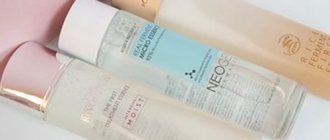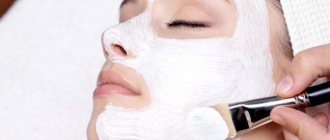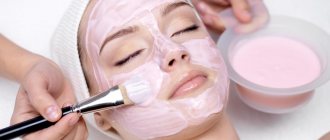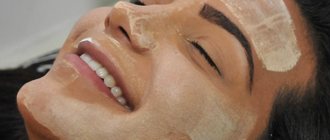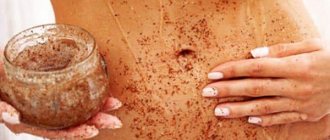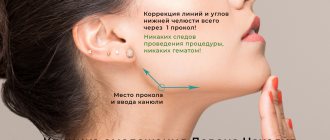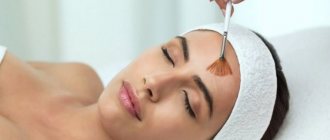The structure of human skin is important information not only for biologists or dermatologists. From the point of view of cosmetology, knowledge in this area helps to overcome age-related changes in the skin, eliminate existing problems and provide the skin with proper care. The structure of facial skin in cosmetology can be called the determining factor in the creation of all miraculous “elixirs” of beauty.
The structure of facial skin in cosmetology
Facial skin structure
Cosmetic procedures aimed at preventing premature aging of the skin primarily take into account its structure. The skin consists of three main layers:
Epidermis
The thickness of the epidermis of the skin varies from 0.03 to 1.5 mm, which includes its five constituent layers - basal, spinous, granular, shiny and horny. Cosmetologists claim that natural face masks, beloved by many women, primarily saturate the upper epithelium, without reaching the deeper layers.
Dermis
The dermis - the skin itself - consists of papillary and reticular layers. There is no clear boundary between them, but it is the latter that is interesting from the point of view of cosmetology. Elastic and collagen fibers are located here, responsible for skin turgor, and sebaceous glands determine the degree of oil content.
Hypodermis
Subcutaneous fat is the last, deep layer of the skin, directly affecting the aesthetic appearance of the skin. Cosmetologists call the hypodermis a store of energy, vitamins and nutrients. Withered skin with obvious signs of vitamin deficiency indicates that cosmetic procedures should be aimed specifically at restoring subcutaneous fat.
For eyelashes
Eyelash growth products
Thick and long eyelashes have always been in fashion, and women used different methods to achieve this goal. For example, in recent years, eyelash extensions have been very popular: from unnaturally lush, reminiscent of a doll's, to more laconic ones, which at first glance cannot be distinguished from natural ones. But despite its enormous popularity, this procedure is not the most beneficial for the eyes. The products used for extensions harm the follicles and can cause ophthalmological diseases associated with inflammation of the eyelids. In addition, young ladies with eyelash extensions should usually refuse some types of facial massage and masks.
Now there is an alternative to extensions - salons offer beauty treatments using products that accelerate eyelash growth. The composition of such products may differ, as well as the result of their use. For example, products based on hormone-like substances prostaglandins and their synthetic analogues can double the size of eyelashes. But at the same time, this procedure does not exclude side effects. Most often – in the form of inflammation of the eyelids [9].
A safer analogue is peptide-based products. They give less modest results, but the risk of side effects is minimal. In addition, such agents, unlike prostaglandins, are suitable for long-term use. But this only applies to beauty products containing exclusively peptides. Some manufacturers combine both components in one product, while others do not separate the entire chemical composition of the drug. These products may be dangerous for people with allergies, sensitive skin or eye conditions.
Keratin lifting
This relatively new beauty salon service has already become a real beauty trend. Keratin lifting is a procedure that allows you to fix the desired curl of your eyelashes. Reed glue is used for fixation, after which the eyelashes are enriched with vitamins, proteins and pigment. After lifting, eyelashes look more voluminous. The effect lasts for 2 months. If the procedure is performed by an experienced specialist, then there should be no side effects. The only note: lifting cannot be done if the mucous membrane of the eye is inflamed, or if you are allergic to the components used.
What is a skin cell made of?
Cytology - the science of cellular structure - is a complex science, the knowledge of which is also important in the cosmetology industry. The basis of each layer of the skin is considered a cell; the physiological and metabolic processes of these layers depend on its proper functioning.
Any skin cell includes:
- Ribosomes;
- Lysosomes;
- Cell membrane;
- Cytoplasm;
- Centrosome with centrioles;
- Vacuoles;
- Mitochondria;
- Core.
Human skin undergoes a constant process of regeneration - the death of old cells and their replacement with new ones. This takes about 2-3 weeks, but with age the process slows down almost by half. Cosmetology is developing all kinds of low-molecular composition products that penetrate the germinal layer and stimulate the appearance of new cells.
Injection techniques
The results from such procedures are longer and more pronounced.
These include:
- biorevitalization, the procedure is performed using injections of hyaluronic acid, allows you to increase skin elasticity, get rid of dryness, smooth out fine wrinkles;
- Botox, the main active ingredient is botulinum toxin, designed to remove wrinkles on the skin by relaxing muscles, with its help you can get rid of crow's feet, folds on the neck and forehead, smooth out the area between the eyebrows;
- plasmolifting, the procedure involves the introduction under the skin of one’s own blood plasma, enriched with nutrients, the method is aimed at producing one’s own hyaluronic acid and collagen;
- introduction of hyaluronic fillers, such injections allow you to fill in lost volumes, making the face more youthful, and can also help people with asymmetry.
Functions, properties and nutrition of the skin
The skin of the face, like the rest of the human skin, performs many physiological functions:
Barrier (protective) function
The skin is a kind of shield from the negative effects of the external environment and prevents the penetration of dangerous microorganisms inside. With a decrease in the protective function, an infection can easily penetrate the skin, and weather conditions will not have the best effect on its condition. Many cosmetics have antioxidant properties and save the skin from free radicals.
Temperature regulation
The thermal conductivity of the skin is quite low, and a decrease in temperature below 18˚ or an increase above 25˚ will certainly affect the condition of the skin. Many cosmetic products are aimed at maintaining the thermoregulatory function: care creams for winter, as well as creams with a high degree of protection from sun rays.
LiveInternetLiveInternet
Tuesday, October 21, 2008 00:04 + to Lafitte’s
all posts by the author Cosmetology, as a scientific discipline, does not stand still.
In its modern form, it has a number of highly specialized areas and the time has come for us, ordinary consumers, to understand what is hidden behind specific professional terms in order to also, as they say, be at the “edge of science.” Cosmetology (from the Greek cosmetic “ability to decorate”, logos “science”) is a scientific discipline that studies methods of diagnosis, prevention, treatment of diseases, elimination of cosmetic defects of the skin, congenital and acquired defects of the head, face and body, as well as testing for the harmlessness of cosmetics created and produced by the cosmetic industry. Cosmetology is closely related to medicine - with dermatology, surgery, trichology, physiotherapy, herbal medicine, aromatherapy, dentistry, as well as chemistry, physics and other sciences. In fact, cosmetology today is a combination of many disciplines and applied skills. Cosmetology is usually divided into medical and aesthetic. Medical cosmetology includes: - diagnostic cosmetology; — dermatocosmetology; - dermatosurgery; — plastic (aesthetic) surgery; — complex hardware technologies associated with violation of the integrity of the skin. Aesthetic cosmetology includes: - preventive cosmetology; — decorative and applied cosmetology; - simple hardware technologies. The task of medical cosmetology is to ensure the normal functioning of the skin, hair and the entire body as a whole. The goal of aesthetic cosmetology is to emphasize a person’s beauty and make defects in his appearance invisible. Let's take a closer look at the areas of modern cosmetology. Diagnostic cosmetology allows you to determine the slightest prerequisites for the occurrence of problems or timely recognize an already begun disease. Dermatocosmetology treats diseases of the skin and its appendages at a medical level. In addition, in modern conditions, an important task of this industry is to check the safety of new cosmetics created and produced by the industry. Dermatosurgery eliminates congenital and acquired cosmetic imperfections of the skin and its appendages (hair and nails) surgically. Today in dermatosurgery the following procedures are performed: - laser skin resurfacing; - surgical dermabrasion; — deep peelings with phenol, trichloroacetic and glycolic acids; — removal of various benign skin formations; — sclerosis of dilated superficial vessels; Ş facial contouring; — gold reinforcement; — artificial and natural hair transplantation. Plastic (aesthetic) surgery deals with cosmetic reconstructive surgeries on the face and body, as well as rejuvenation surgeries. Plastic surgery includes abdominoplasty, rhinoplasty, mammoplasty, liposuction, etc. Aesthetic cosmetology, in turn, has two directions: preventive and decorative. Both industries allow the use of simple hardware technologies. Preventive cosmetology deals with issues related to maintaining the normal functioning of the human body as a whole and, in particular, skin, hair, and nails. Preventive cosmetology implies: - healing the body using various methods, promoting and maintaining an active lifestyle, rationalizing nutrition, establishing the correct sleep and wakefulness regime, strengthening the nervous system; — selection of optimal products for daily care of hair, nails, facial and body skin using myostimulating, lymphatic drainage and other equipment that does not violate the integrity of the skin. Major nail diseases are dealt with by onychopathy specialists. Onychopathy is the general name for nail diseases. Onychopathies have been described by everyone, from Hippocrates to modern researchers. By the appearance and condition of the nail, just like by the condition of the skin, you can determine general diseases of the body. As mentioned above, a cosmetology specialist must know the symptoms of various diseases of the skin, hair, and nails in order to promptly refer the patient for treatment to a dermatovenerologist or trichologist. Trichology is the science of hair and scalp, their diseases, problems of aesthetics and hair care. She studies the structure and growth phases of normal (unchanged) hair, and also develops theoretical and practical methods for the prevention of diseases and treatment of hair and scalp. The task of trichology is to ensure the normal functioning of the hair and the entire body as a whole. This science is associated with medicine - with dermatology, cosmetology, surgery, therapy, as well as with chemistry, physics and other sciences. Trichology is considered in three aspects: preventive, diagnostic and therapeutic. Preventive trichology prevents the occurrence of a problem, diagnostic trichology makes it possible to promptly and correctly recognize the disease, and therapeutic trichology allows you to cure the disease using therapeutic and surgical methods. https://www.portal-woman.ru/ Articles on similar topics: Plastic surgery. Pros and cons. How closely are appearance and age related? TWO ANTI-CELLULITE REMEDIES
| Categories: | Personal care |
Tags:
cosmetology trichology aesthetic cosmetology onychopathy preventive cosmetology medical cosmetology laser skin resurfacing
Cited 3 times
Like share
0
Like
- I liked the post
- Quoted
- 0
Saved
- Add to quote book
- 0
Save to links
Liked
0
Hardware procedures
Such techniques help increase the production of your own collagen. They work on electric current, ultrasound and laser influence:
- laser rejuvenation, the laser affects the upper and middle layers of the dermis, as a result of which fine wrinkles disappear, the skin becomes more elastic and toned;
- radio lifting, the thermal energy of radio waves affects muscle contraction, causing cell renewal;
- the use of microcurrents, low frequency currents tone muscles and blood vessels, accelerate metabolic processes in tissues;
- photorejuvenation, light waves penetrate the epidermis, destroying melanin in areas with excess pigmentation, allowing the skin to look more even;
- ozone therapy, during the procedure ozone is injected under the skin, increasing blood flow; a good effect can be obtained in the presence of age spots and stretch marks.
Cosmetology in terms of advantages and disadvantages
The positive side of the spread of cosmetology services is the liberation of a person from complexes formed as a result of awareness of the defects of one’s own appearance. This is understandable, because the desire to look good is common to people of any age, social status and gender. Confidence in one’s own attractiveness improves an individual’s mood, the microclimate in a team, and productivity at work. But to complete such a task you will need an experienced, professionally trained cosmetologist. The key to success is a number of specialist actions:
- determination of skin type and attention to the results of the patient’s examination;
- prescribing medical procedures and medications with a guarantee of individual effectiveness and the absence of negative effects on the body;
- masterly performance of a session of hardware cosmetology and other tasks.
But there are cases when the desire for results can be accompanied by side effects of the following types:
- allergic reaction;
- skin redness, swelling, inflammation;
- the need for rehabilitation (for a number of procedures);
- tingling sensation.
To avoid such effects, you should carefully study the indications and contraindications for a particular procedure.
